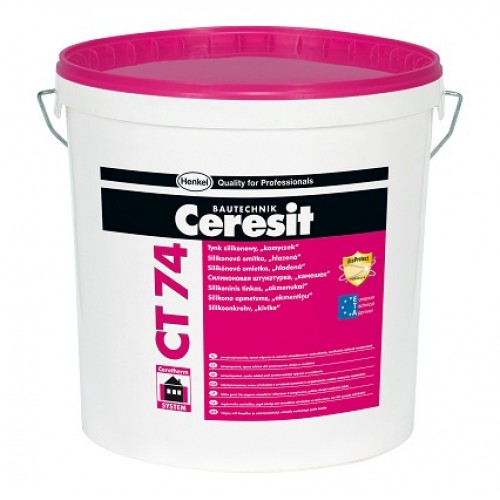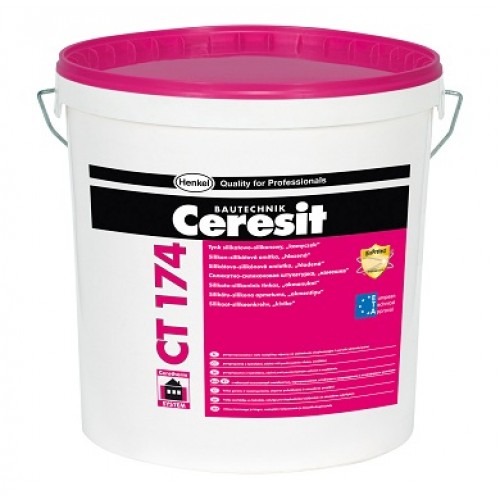Comparing Ceresit Silicone and Silicone-Silicate Renders
by Mark Row
 Give Your Home a Great Finish
Give Your Home a Great Finish
Silicone and silicone-silicate renders could be a right choice for giving your home a great finish. Choosing the right kind of render will depend on various factors, including the surface it is being applied on, insulation material it is combined with, but also your personal preferences, bearing in mind their look. This is why it is good to know some basic differences between different render types available but also some basic characteristics of named Ceresit silicone and silicone-silicate renders which could help you make up your mind.
Render Types Overview
Depending on various factors, including your insulation system, mineral, silicone, silicate, silicone-silicate, acrylic or mosaic renders could be your choice.
Mineral renders have a cement and mineral fillers structure, with biocides added, affecting their mould, fungi and other mikroorganizm resistance and making them very vapour permeable, especially suitable for high moisture areas and perfectly combined with mineral wool insulation products, due to their non-flammability.
Silicone renders are consisted of silicone resins and mineral fillers, they are very dirt, weather and UV radiation resistant, all making them very durable. Silicate renders are based on liquid potassium glass mixed with mineral fillers, why they are, like mineral renders highly applicable in humid places and successfully combined with both mineral wool and polystyrene insulation products. Silicone-silicate renders present a perfect mixture of silicone and silicate renders combining and emphasizing basic advantages of both render types.
Acrylic renders are consisted of acrylic being a flexible and resistant type of plastic. These renders are very fast drying, offer a decorative finish, from smooth to textured one and can be applied to various surfaces, including concrete blocks, painted walls, cement sheeting or polystyrene. It is usually rolled on, but can also be sprayed onto the surface, depending on the render type.
Finally, mosaic renders offer a decorative finish, consisting of transparent resins and coloured gravels, used both on internal walls susceptible to harsh conditions and external walls subject to dirt and dust.
When opting for the best rendering system, know that acrylic and silicone renders are closer to one another with more similar characteristics and applications, just like mineral and silicate renders are usually connected, due to their inflammable structure allowing them to be combined with more than one insulation material. Knowing their basic characteristics, you can come to a conclusion that mineral and silicate renders should be applied in high humidity places, due to their low absorption and places where there are more biological hazards, like microorganism growth due to their mineral and less organic composition. On the other hand, acrylic and silicone renders could be a better choice for polluted areas, where contamination risk is higher, due their sealed structure or in buildings over-exposed to sunlight and other discolouring factors, since these are much more resistant to these external influences.
CT 74 Silicone Render Description and Application

Ceresit CT 74 Silicone Render is available in 1.5mm and 2.5mm grain size, made from mixture of silicone resins, polymers, fillers and size aggregate. The good news is that it is available in more than 160 colours and pre-mixed and coloured which makes it very easy to apply. It can be used on different stable and dry surfaces, but is best combined with substrates like Ceresit CT 85 and CT 87 mortar layer, reinforced with CT 325 Mesh, added to thermal insulation.
Certain precautions should be taken prior to CT 74 silicone render application, including checking the soundness of the substrate, since any loose surface needs to be removed. The next thing you will have to check are contaminants like dirt, dust, oil, grease which need to be properly removed and the surface left to dry. Finally, if there is any coating (sound or vapour permeable), you’ll need to clean and abrade them. Certain porous surfaces need to be properly primed in order of increasing render adhesion and left to dry for at least three to four hours before applying the render.
When applying CT 74, make sure it is not exposed to direct sunlight, rain, wind or cold, which means that you will make sure that the weather conditions will not interfere with your work. Optimal application temperature is between 5° and 25° C. Also make sure to properly protect yourself by using protective equipment and perform the work in a well ventilated space. Now, simply mix the product using a drill and an adequate attachment and apply it onto the surface using plastic or stainless steel tools, protecting it from water splashes. If you have opted for 1.5 mm grain size you will need approximately 2.1 to 2.5 kg/m2, while the ratio with 2.5 mm grain size is 3.8 to 4 kg/m2. Spillages can be cleaned by scrapping and washing with clean, but if already hardened you will need to use mechanical means.
CT 174 Silicone-Silicate Render Description and Application
 CT 174 Silicone-Silicate Render, as previously explained, is a render type combining all the good sides of silicone and silicate renders, used on various surfaces like gypsum and concrete substrates, chipboards or traditional renders, combined with mineral wool and polystyrene insulation boards, but best not applied to highly insulated walls. It is available in more than two hundred colors, hydrophobic, UV, dirt and weather conditions resistant and vapor permeable.
CT 174 Silicone-Silicate Render, as previously explained, is a render type combining all the good sides of silicone and silicate renders, used on various surfaces like gypsum and concrete substrates, chipboards or traditional renders, combined with mineral wool and polystyrene insulation boards, but best not applied to highly insulated walls. It is available in more than two hundred colors, hydrophobic, UV, dirt and weather conditions resistant and vapor permeable.
Before applying the CT 174 silicone-silicate render, make sure that the surface is properly cleaned and sealed preventing the moisture from damaging the render. Stir the product using stainless tools and add some clean water in order of adjusting the renders consistency. Use approximately 2.5 kg/m2 for to 1.5 mm grain size and 3.4 to 3.7 kg/m2 for the 2.5 mm grain size. It is important to apply the render in optimal weather conditions (preferably at 5° and 25° C and humidity below 80%), since this will affect drying process. When applied, make sure that it is properly protected from the rain until it dries.
If you need more information about Ceresit Renders feel free to post your questions in the comments section below.











































































































